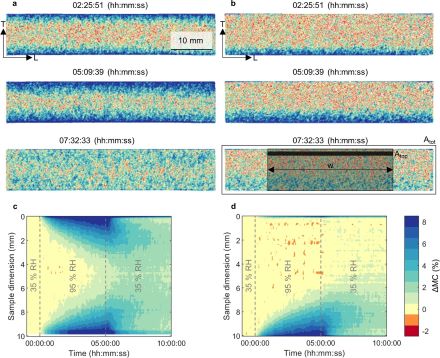Bio-engineered Wood
Microorganisms (fungi, algae, lichens and bacteria) can colonize biofilms, shorten their life span, impair their function and aesthetic appearance and cause hygienic problems. Most fungi are considered to be a public safety hazardalthough the beneficial effects of fungi far outweigh their negative. If they are applied selectively they can optimize material properties. For pure and appliedresearch we use a range of fungal species and enzymes to positively enhance the properties of wood. The application of wood inhabiting fungi results ina significant improvement of the acoustic properties of tonewood. Wood durability of refractory, native tree species such as Norway spruce and Fir is enhancedby the bioincising process which results in a significant increase in wood permeability. Bioincising is a promising technology to enable an efficient distributionof wood modification substances and to promote the efficiency of the desired property improvement.
Mycowood: improved acoustic properties for violins
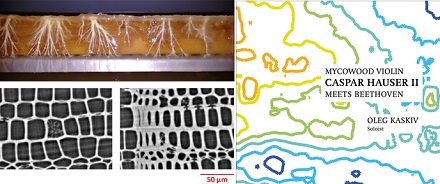
The quality of wood for the manufacture of music instruments (tone wood) is determined by its physical properties. Wood with a low density and high velocity of sound and modulus of elasticity is favored for string instruments making. The objective of our investigations is to improve the physical quality of tone wood, e.g. reduce the density, and thus increase the sound radiation by exposing it to specific decay fungi under controlled conditions. The latter fungi differ from most other fungi, as they reduce density but do not degrade highly lignified cell wall regions resulting only in negligible changes in the stiffness and velocity of sound which are thought to be important for the sound quality of string instruments.
With the support of the Walter Fischli-Foundation we have developed a procedure which did result in mycowood of optimised quality and physical stability. Violins have been built by two different makers using the incubated mycowood and its non-incubated controls. Studies are being designed which will show the differences of these violins in sound characteristics and acoustic properties at Empa, and their psycho-acoustic differences by CD recordings at the sound design studio "Idee und Klang" in Basel. A first mycowood violin, a copy of the "Caspar Hauser" violin by Guarneri del Gesú, was recorded with a movement of the violin concerto by Ludwig van Beethoven with soloist Oleg Kaskiv and the Gstaad Festival Orchestra, and demonstrates its fine and differentiated sound.
Fungal Bio-battery
Using wood decaying fungi called white rot fungi and algae commonly found in freshwaters, this project aims to develop a portable, single use biodegradable bio-battery. As part of the project, the Cellulose Biohybrids group is optimizing the bio-battery matrix, which is made of a combination of cellulose nanocrystal (CNC) and cellulose nanofibril (CNF) material. After screening, selected microorganisms from above will be 3D printed onto the CNC/CNF material (Figure 1). Currently the Bioengineering group is optimizing the growth parameters of the most promising fungi to combine these with specific algae. The goal will be to create a symbiotic relationship between the fungi and algae so that they rely on each other. Ideally, the fungi will provide the algae with carbon dioxide and sugars for growth and in the presence of light, the algae in turn will provide the fungi with oxygen and essential elements for growth. We produce and purify our own fungal melanin to enhance the conductive properties of the CNC/CNF matrix.

Microstructure-property relationship in varnished wood of string instruments
Wood varnish coatings are not only aesthetically important, but also preserve the musical instrument from wear and fluctuations in the ambient humidity. Depending on the thickness, extent of penetration into the wood and the physical and mechanical properties after hardening, varnishes may change the mechanical and also vibro-acoustical properties of the coated wood. Although some recent studies suggest that solists cannot distinguish between high quality contemporary violins and historical ones still the soloists and collectors believe in the superior quality of sound of the former violins manufactured by Cremonese masters, and the quality of their timber and varnish. Our ultimate goal is to contribute to the scientific understanding of the role of the varnish composition and its structure at the wood-varnish interface on the vibro-acoustics of string instruments. This knowledge helps to develop a generation of high quality varnishes for string instruments.
Spatial changes in MC compared to the initial equilibrated wood MC at 35% RH for (a) an unvarnished control and (b) a sample treated with a multi-layer varnish system with four layers of alcohol varnish on the top surface (N + S + G + A) after 2.5 h (top) and 5 h (middle) at 95% RH and after 2.5 h of desorption (bottom) (humidity was decreased to 35% RH after 5 h). Change in MC profiles from the top (0 mm) to bottom surface (10 mm), averaged over the width w=30 mm for c the unvarnished reference sample and d the sample with complete varnish system.
Enhanced permeability of spruce by fungi modification
Aspiration of bordered pits in Norway spruce wood is the main reason why the treatibility with preservatives is greatly inhibited for increasing the durability against micro-organisms. If this restriction could be overcome wood could be treated more effectively. For this purpose Norway spruce wood is exposed to the white-rot fungus Physisporinus vitreus that selectively degrades the pit membranes, without altering the mechanical properties of wood. At present we are undertaking studies to optimize conditions under which the colonization of wood by the fungus is improved with the objective to upscale our patented procedure as a biotechnological method for industrial purposes.
Laccase-catalysed iodination of wood for achieving antimicrobial effects and protection against microbial degradation
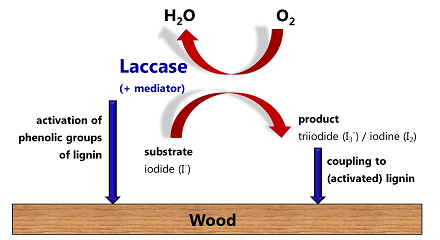
Current methods of functionalization of wood and wood-based materials for antifungal and antibacterial effects rely mainly on the adsorption of bioactive (toxic) compounds. Exposure to physical and chemical forces of the environment, particularly to water, mostly leads to rapid loss of efficacy of antimicrobial surfaces due to leaching. Our studies show that laccase-catalysed oxidation of iodide can be used for generating leaching resistant antimicrobial wood surfaces which effectively prevent colonization against different classes of heterotrophic microorganisms, including enteric bacteria, yeast, bluestain and wood decay fungi.
Development of a biological control method to eradicate the inoculum of copper tolerant fungi in the soil of wood products using antagonists
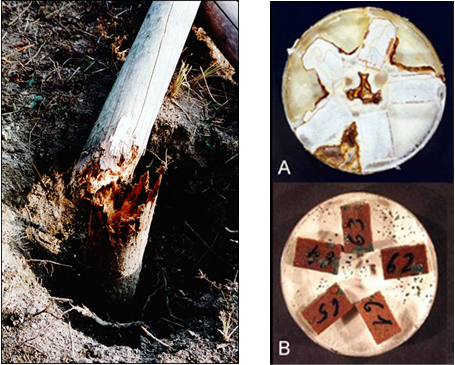
Wood poles impregnated with copper based wood preservatives are popular and used in the telecommunication and power supply industries all over the world because of their high strength per unit weight, low installation and maintenance costs and excellent durability. Premature failure of wood poles is often the result of wood decay caused by copper tolerant fungi. The objective of this project is to develop a biological control method that can be applied for eradicating copper tolerant fungi of the genus Poria in the soil surrounding wood products. For the purpose we will isolate a range of antagonists from soils on different sites in Europe in which early failure of wood poles are commonly encountered. Once we have isolated and identified the copper tolerant fungi we will complete a range of in intra and in vivo studies that we will enable identification of an antagonist. If this approach is successful it should be possible to drastically reduce the number of early failures of wood poles and other wood products in Europe.
Figure above: Early failure of a wood pole, which was impregnated with a chromium copper formulation. The copper tolerant fungus Poria placenta = Rhodonia placenta was isolated from the decayed wood. Pic.A: Dense, with mycelium has colonized the wood of an incubated control specimens. Pic.B: After pre-treatment with the antagonist T-Cu+ wood specimens were not colonized by Rhodonia placenta.
Tonewood
Superior tonewood has a low density and high Young‘s modulus of elasticity. The acoustic properties of Norway spruce and Sycamore wood can be improved with a controlled degradation process.
Bioincising
Wood of Norway spruce and white Fir is weakly durable, has a low liquid permeability and can be only poorly treated with selected wood modification substances.
Fungal biotechnology
Wood decay fungi secrete enzymes which specifically attack the wood polymers. Lignin-degrading enzymes such as laccases can be used for green chemistry, or the production of wood compound materials.
Competences / methods
- Determination of the cause for microbial decomposition of wood plastics, metals, organic and an organic materials
- Research on the selective modification of wood with fungal species and fungal-derived enzymes
- Elucidation of the durability of wood against microorganisms under different environmental conditions
- Determination of the efficiency of wood preservatives and wood modification methods against microbial colonization and decomposition.
Development of an industrial process for spalting wood in high value furniture applications
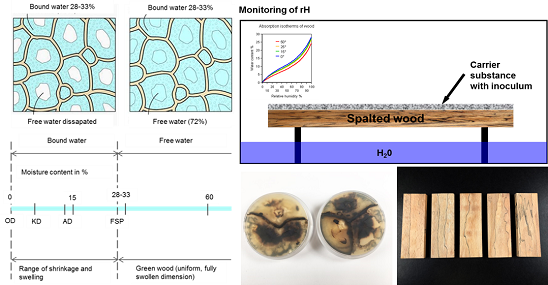
Spalted wood is defined as any colouration in wood caused by a fungus. Spalting occurs naturally in old mature wood but younger wood can also be manipulated by scientists using fungi to create designs of artistic merit that is highly sought after in the high end furniture market. There are two kinds of spalting, zone lines and pigmentation and we are most interested in the former. Zone lines are caused when two fungal strains (genotypes of the same species) or two separate species make contact with each other in the wood. When contact is made, one or both fungal parties form a zone line as a means of demarcation in order to protect their niche or food reserve from the competition.
The main incentive behind this project aside from a high customer demand for spalted wood in decorated wood markets, lies in the fact the tree species favoured for spalting are normal-ly burnt as energy wood in Switzerland. The chosen tree species’ - sycamore, maple, and ash - have limited sales properties outside of energy wood, which is due to abnormal growth formation, frequent fork development, false heartwood, ring shakes, and a generally bright and unattractive wood. The aforementioned flaws provide a market opportunity for spalted wood.
Together with our Swiss industrial partner, Koster AG, we aim to develop a standardised method for spalting wood with unique patterns using 13 genotypes of Kretzschmaria deusta selected from a single storm damaged beech tree, alongside Trametes versicolor and T. pubescens.
Three locally grown tree species- sycamore, maple, and ash - were selected based on their receptiveness to spalting, the pale colouration of the wood, and the added value for furniture applications. Our desire is to: (1) develop a simple, fast and standardized method for spalting wood, (2) use monocultures to optimise and standardise treatments, (3), reduce costs by selecting fungal species’ that thrive in low wood moisture conditions, (4) and use fungi that maintains wood me-chanical properties. The project will increase our knowledge of spalted wood applications. The con-cept will appeal to customers’ artistic senses and develop a niche market using naturalised tree species grown in Switzerland for the high-end furniture market.
Development of a biopolymer based carrier substance for biological control of internal decay in utility poles
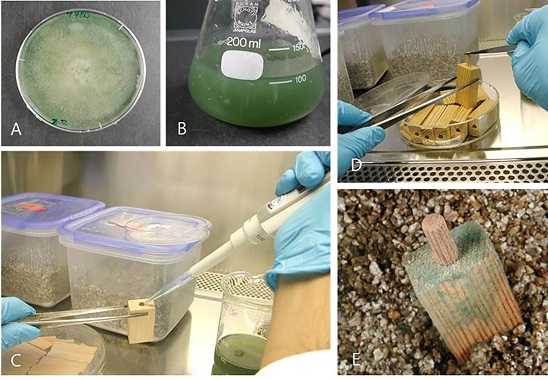
Although wood decay fungi are well known for their ecological importance, they may also have an effect on the strength and stability of wood products such as utility poles. In Germany premature failure of wood poles causes an approx. damage of 36 million € per annum.
In this Innosuisse project, in collaboration with Impregna GmbH and MycoSolutions AG, we aim to use Trichoderma spp. as a biocontrol agent to eradicate internal wood decay fungi in utility poles. The antagonistic potential of Trichoderma is based on different mechanisms, e.g. the production of antifungal metabolites, competition for space and nutrients and mycoparasitism. For this purpose fungal species that cause internal decay in utility poles from different sites in Switzerland wll be isolated and identified by PCR. After screening the antagonistic potential of a range of Trichoderma species in vitro against the most common wood decay fungi, the compatibility of six water-based carrier substances (polymers) and propagules of Trichoderma spp. will be investigated.
After assessing the potential of selected Trichoderma spp. to survive and grow in wood of Norway spruce, a carrier substance will be developed, that has the appropriate rheology properties for usage by the Cobra system of Impregna. For successful application, the T-720 propagules must be able to survive in space and time for prolonged periods.

